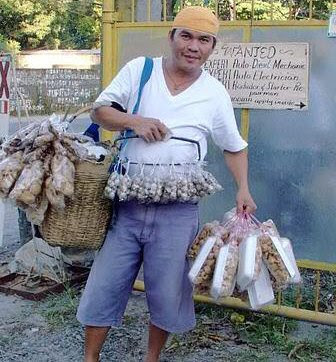In Philippines, you can observe various street foods being sold in any part of the busy city streets or at the small community. 

barbecue vendor
Street food is food obtainable from a streetside vendor, often from a makeshift or portable stall with the very affordable prices. Most street food is both finger and fast food.The most common Philippines street foods include fried squidballs, fishballs, kikiams (a type of processed chicken, which are served on a stick, with a variety of dipping sauces). 
fish balls and squidball vendor
Roadside stands also serve barbecued pork, chicken and offal, such as pig's blood (colloquially, Betamax after its rectangular shape), chicken heads (helmet), chicken feet (adidas) pig's ears and chicken intestines (isaw).
 Among more esoteric foods are balut and penoy (duck eggs; with fetus and without, respectively), tokneneng and quek-quek (battered, deep-fried chicken and quail eggs) and deep-fried day-old-chick.
Among more esoteric foods are balut and penoy (duck eggs; with fetus and without, respectively), tokneneng and quek-quek (battered, deep-fried chicken and quail eggs) and deep-fried day-old-chick. selling balut, chicharon and boiled quail eggs (above)
selling balut, chicharon and boiled quail eggs (above) balut (from youngest to eldest chick)
balut (from youngest to eldest chick)
You can also discover Taho, a type of soft beancurd served with syrup and tapioca balls is another snack.
 taho
tahoPalamig (literally, coolers) are sold, such as traditional offerings like halo-halo (halo means mix) and many kinds of fruit juices. Sorbetes (or, colloquially, "dirty ice cream") and locally-produced ice-cream in exotic flavors such as mango, cheese and yam.
 There are a lot more street foods that i have not mention. It's up to you to discover those foods when you will visit Philippines.
There are a lot more street foods that i have not mention. It's up to you to discover those foods when you will visit Philippines.






